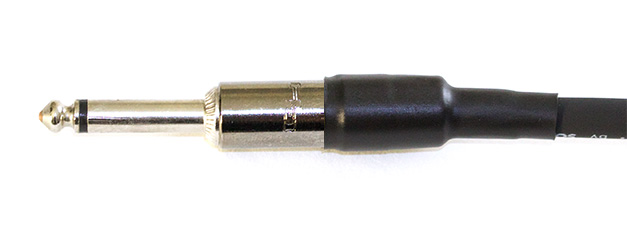DIY VS PREMADE GUITAR CABLES
From: Shootout Guitar Cables UK • Best Guitar Cables Explained
See also: The Shootout Guitar Cables Range
BUY 'Black Powder' St-St 3m Guitar Cables on eBay - CLICK HERE! BUY 'Black Powder' St-Ra 3m Guitar Cables on eBay - CLICK HERE! |

|
This business was started as a result of a professional guitarist thinking that it would be cheap and 'quite easy' to make his own guitar and other cables for his studio rather than buying premades.
Once he realised that good soldering was somewhat an art and took a fair amount of practise, that lead free solder was much more difficult to use than lead containing solder, and that the price of the proper soldering equipment required made decent premade costs insignificant he appreciated the wonderousness of the premade once again!
However along the way he also learnt about how a passive electric guitar pickup has a high output impedance and coil induction, and how cable capacitance and input impedance then forms a circuit with the pickup and that this pertains demonstrably and considerably to tone.
He also realised that most of the premade cables industry and their retailers have been using highly subjective terminology to shift their cable products, and that reviewers have been using equally subjective terms whilst either not knowing what they are hearing and why, or worse comparing apples to oranges (i.e. different length cables!) and so SHOOTOUT! was born.
Most premades only specify length and present an irrelevent shiny gold connector or flimsy logo printed heatshrink*, don't list cable capacitance and other signifiicant specifications, and use a barrage of subjective marketing words surrounding tone, with a brand name attached.
We won't ever sell anything we wouldn't be happy to buy ourselves, and where cables are concerned, we won't compare apples to oranges or explain tonal differences in cables using the lexicon of terms favoured by the Cable Fairy without explaining the reasons why you hear what you are hearing between different cables.

*We did enjoy testing our strain relief prototypes (like pulling as hard as possible on the arms of a Stretch Monster or Stretch Armstrong) and watching the whole cable break apart after the glued heatshrink rather than the solder connections taking the strain with the cable pulling through jack plug casing... result! 8O)
BUY 'Black Powder' St-St 3m Guitar Cables on eBay - CLICK HERE! BUY 'Black Powder' St-Ra 3m Guitar Cables on eBay - CLICK HERE! |

|
Also in this guide:
Guitar Cable Capacitance and Resonant Frequency
Guitar Cable Capacitance Chart
Guitar Cable Length and Signal Loss
Guitar Cable Myths and The Cable Fairy
Guitar Cable Shielding and AC Hum
Guitar Cable Microphonics and the Triboelectric Effect
Braided vs Spiral vs Foil Guitar Cable Shielding
True Bypass Pedals vs Buffered Pedals
Silver Plated Copper Cables and 'Red Plague' Galvanic Corrosion
Copper vs Silver Signal Conductor Guitar Cables
Gold Plated Guitar Cable Jacks and Galvanic Corrosion
Guitar Cables vs Guitar Pedal Board Patch Cables
Analogue Guitar Cables vs WIFI
Low Capacitance vs High Capacitance Guitar Cables
Oxygen Free Copper Guitar Cables
Cheap vs Midrange vs Expensive Guitar Cables
Glued Heat Shrink vs Unglued Heat Shrink Guitar Cables
